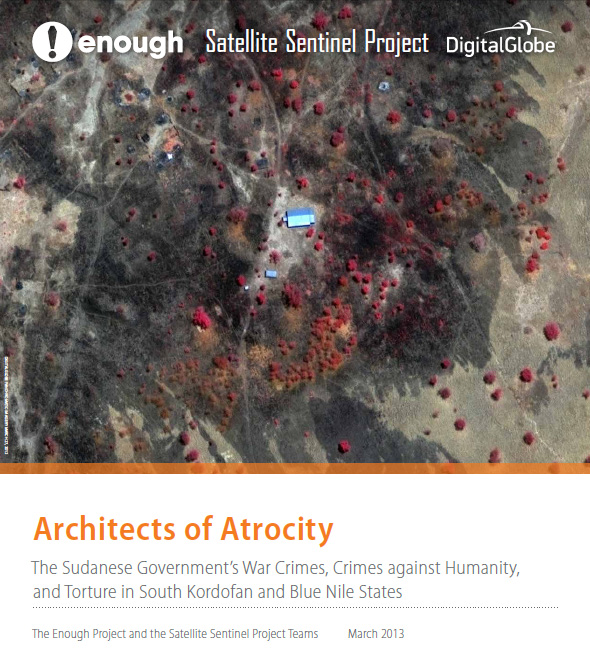
Over the past two years, the Satellite Sentinel Project, or SSP, has had its eyes – a constellation of DigitalGlobe satellites – on the border between the Sudans, watching for, reporting on, and alerting policy makers and the public to evidence of mass atrocities, crimes against humanity, and war crimes.
In a new report complete with legal analysis, SSP and the Enough Project have compiled compelling evidence – including DigitalGlobe satellite imagery and analysis, eyewitness reports, photos, and video – documenting evidence of crimes by the Khartoum regime that can and should be referred to the U.N. and to the International Criminal Court.
The imagery in this report is not comprehensive, but instead exemplifies the kinds of attacks characteristic of armed forces aligned with the government of Sudan, including Sudan Armed Forces, the notorious Central Reserve Police known as Abu Tira, and the government-sponsored Popular Defense Forces, or PDF militia.
SSP and Enough have exposed the widespread and systematic killing of civilians who were suspected of supporting the rebelling Sudan Peoples Liberation Movement-North, or SPLM-N. SSP documented evidence of eight apparent mass graves, including eyewitness reports and satellite imagery acquired by our partner DigitalGlobe, in and around Kadugli, South Kordofan. In collaboration with Eyes and Ears Nuba, a group of Sudanese journalists, SSP has also obtained and published cell phone video evidence of looting, burning, and torture.
The DigitalGlobe Analytics Center has documented the deliberate burning of at least 26 villages in South Kordofan state and 16 villages in Blue Nile state, plus 292 square miles of burned land in both states combined. The total documented burned area is three times the size of Washington, DC, and includes farms, orchards, and grasslands used for grazing cattle. Deliberate destruction of means of food production, a willful attack on civilian infrastructure, is a war crime.
We’ve seen these tactics used before – against the South Sudanese during the North-South civil war from 1983-2005, causing the deaths of 2 million civilians and the displacement of 4 million, and also in Darfur, where approximately 300,000 people have died and 3 million have been displaced. As the government of Sudan continues its pattern of destruction in South Kordofan and Blue Nile, the report calls for the establishment of a U.N. commission of inquiry and possibly further investigations by the U.S. government and other international actors is necessary to uncover the full extent of the Sudanese government’s crimes, as well as the expansion of the International Criminal Court’s Sudan mandate to stop the violence.
DigitalGlobe satellites continue to monitor the situation alongside citizen journalists operating in South Kordofan and Blue Nile. Since the acts discussed in this report are likely only an outline of the full extent of realities on the ground, the report calls for the international community to do more to investigate the war crimes, crimes against humanity, and torture being perpetrated by Sudanese government forces against their own people.
Read the report: Architects of Atrocity: The Sudanese Government’s War Crimes, Crimes against Humanity, and Torture in South Kordofan and Blue Nile States
View or download the DigitalGlobe satellite imagery on Flickr.

